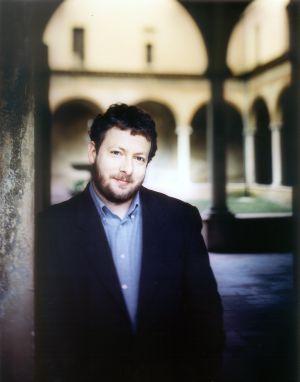
Fabio Biondi, violinist |
After singing for the Holy Father and the American bishops on Wednesday, I had plans to get a head start on the crowds for the trip back to Capitol Hill. That evening was one of the most anticipated concerts on the Library of Congress series, featuring Europa Galante, a leading Italian historically informed performance (HIP) ensembles. Unfortunately, the Secret Service and MPD shut down the route of the Pope's motorcade way too early, cutting off our path to the Metro for an hour and a half until the Pope left the National Shrine. So I arrived at the Library in time to hear only the second half.
Thanks to a switch in the program, the first piece after intermission was the D minor concerto by Vivaldi, RV 540, for viola d'amore and lute. The group's leader, Fabio Biondi, had a spiky, electric sound on the viola d'amore, but it was Giangiacomo Pinardi's performance on the lute that impressed most, featured regularly in solo episodes with the violin section on the bass line. After the group's superlative debut complete opera recording of Vivaldi's Bajazet, this live concert was, perhaps inevitably, a disappointment. The intonation, especially from the cello, was disturbingly rough at times, and Biondi's solo work, although ingeniously embellished with ornaments, cut against the ensemble grain more than floated above it. The Suite "Les Nations," Biondi's arrangement of various national dance movements, was a series of pleasing diversions, composers of one nationality aping the musical stereotypes of another. The most striking moment of the evening was the pizzicato dessert, a "little dance" from Gluck's ballet Don Juan.
Other Reviews:
Stephen Brookes, Holloway/Linden/Mortensen Trio (Washington Post, April 19)
Matthew Guerrieri, Trio demonstrates collaboration in the midst of contrasts (Boston Globe, April 14)
Anne Midgette, Crossing Borders but Often Going Nowhere (Washington Post, April 18)
Bernard Holland, World Tour, in a Baroque Sort of Way (New York Times, April 14)
Joshua Kosman, Daring Europa Galante approach boosts Vivaldi (San Francisco Chronicle, April 7)
Chris Pasles, Live: Europa Galante (Los Angeles Times, April 3) |
Never one to complain of hearing too much Baroque music, I was back at the Library of Congress on Thursday night for a recital by three leading HIP soloists, violinist John Holloway, cellist Jaap ter Linden, and harpsichordist Lars Ulrik Mortensen. Holloway's sound held up to expectations from his recordings for the ECM New Series, the last reviewed being his unaccompanied Bach. The playing was more solid, less wild than Biondi's, with ethereal high sound in the slow movements but occasional missteps in intonation.
The best part of the evening was the discovery of two sonatas by Jean-Marie Leclair (1694-1764) and one of the sonatas of Francesco Maria Veracini (1690-1768). The latter especially makes for an instructive comparison to the highly chromatic harmonic language of J. S. Bach. Veracini's op. 2, no. 12 (D minor) has not one but two Passagallo (Passacaglia) movements, as well as a chromatic capriccio on two subjects and their inversions. Programmed at the end of the recital, this work was a suitable climax, followed by a lovely encore from another of the composer's sonatas, a set of variations on a Scottish air. Jaap ter Linden excelled in Vivaldi's cello sonata no. 7 (G minor, RV 4), especially the thrilling moto perpetuo of the concluding Gigue. As an example of the sonata da camera, the precursor of the suite, the Vivaldi was brilliantly paired with a superior Corelli violin sonata (op. 5, no. 8, E minor).
Lars Ulrik Mortensen had his own admirable solo moment in Les Barricades Mistérieuses, from Couperin's sixth ordre for keyboard, evenly articulated as it wandered harmonically. Another welcome discovery was the music of Joseph Bodin de Boismortier (1689-1755), represented by a trio (op. 37, no. 5, A minor), with its slow movement accompanied on the harpsichord's lute stop and the final movement with a folk dance middle section. While the audience for both concerts was surprisingly not completely full, the even lower attendance for this recital was doubly a shame because of the quality of music-making.
The next concert on the free series at the Library of Congress features Camerata Pacifica (April 24, 8 pm).






















































No comments:
Post a Comment